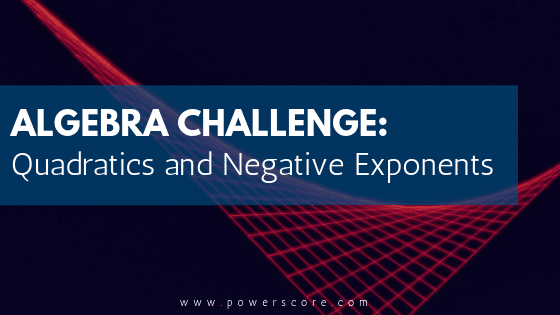GRE algebra questions will occasionally hit you with a quadratic equation. To solve it, you won’t need the quadratic formula. You probably won’t even need the FOIL method. GRE Quant permits—and often rewards—problem solving methods that buck the conventions taught in high school math classes. To see what I mean, try these two algebra problems that most test takers would likely miss.
Difficulty Level: 4 (High)
Algebra: Quadratic Equations, Exponent Rules
The Challenge
In The Practice Book for the Paper-based GRE, one of the harder Quant questions asks you to solve a quadratic equation that includes two negative exponents. (See §6, 24.) Only 38% of examinees got the question right when it was on a real exam. Here’s a pair of problems that match it in difficulty.
- If x−2 + 2x−1 − 24 = 0, which of the following could be the value of x?
- 4
- 1/6
- −1/6
- −1/4
- −6
- If 2y−2 + 3y−1 − 14 = 0, which of the following could be the value of y?
- 2
- 1/2
- 2/7
- −1/2
- −7
The Solutions
Step 1: Apply the Negative Exponents Rule.
Switch each exponent from negative to positive by flipping (finding the reciprocal of) its base. Be careful. Exponents precede multiplication in order of operations, so 2x, 2y, and 3y aren’t the bases here. Just x and y are .
a−n = 1/an
- x−2 + 2x−1 − 24 = 0
- 1/x2 + 2(1/x) − 24 = 0
- 2y−2 + 3y−1 − 14 = 0
- 2(1/y2) + 3(1/y) − 14 = 0
Step 2: Simplify.
Add away the zero, factor away the exponent, and remove the parentheses by multiplying away a fraction. Don’t push to impose quadratic form. Instead, set up the equation for easy arithmetic in Step 3.
- 1/x2 + 2(1/x) − 24 = 0
- Add 24 to both sides.
1/x2 + 2(1/x) = 24 - Factor out 1/x on the left.
1/x(1/x + 2) = 24 - Multiply both sides by x.
1/x + 2 = 24x
- 2(1/y2) + 3(1/y) − 14 = 0
- Add 14 to both sides.
2(1/y2) + 3(1/y) = 14 - Factor out 1/y on the left.
1/y(2(1/y) + 3) = 14 - Distribute the 2 and Multiply both sides by y.
2/y + 3 = 14y
Step 3: Plug the answer choices into the equation.
The correct answer is the option that makes the equation true. Start by eliminating option (A) with a quick bit of mental estimation. In problem #1, for instance, think about what happens when you stick 4 in the equation: the right-hand side, 24 × 4, is bigger and thus unequal to the left, 2 + 1/4. So move on to option (B).
- 1/x + 2 = 24x
- Try option (B) 1/6.
1/(1/6) + 2 = 24(1/6)
6 + 2 = 4 FALSE - Try option (C) −1/6.
1/(−1/6) + 2 = 24(−1/6)
−6 + 2 = −4 TRUE - Thus, (C) is correct for #1.
- 2/y + 3 = 14y
- Try option (B) 1/2.
2/(1/2) + 3 = 14(1/2)
4 + 3 = 7 TRUE - Thus, (B) is correct for #2.
Step 4: Backplugging.
You exploit the question’s use of multiple-choice by plugging the options back in to the problem. Before long, the right answer reveals itself through simple arithmetic. When you get a hard-to-solve algebra equation in GRE Quant, just remember that you’re not taking a high school math test; you’re taking a grad school admissions exam. Although high school math methods can work on the GRE, alternative approaches such as backplugging can often be faster and easier.
Ready for more? Check out some of the Hardest and Most Tested Math Topics on the GRE.


Leave a Reply
You must be logged in to post a comment.